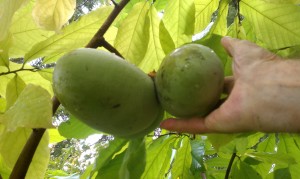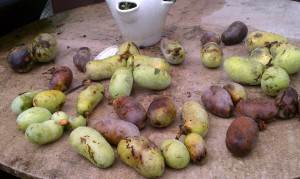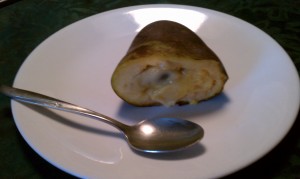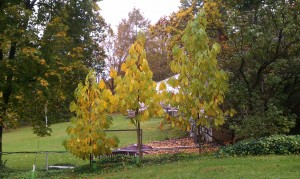It’s a Paw Paw time of year again! The last of the fruits are ripening up for a succulent feast on the yummy custard filling complete with a biodegradable cup!
What is a Paw Paw you ask? You are in for a real treat…Asimina triloba, for better or worse, known as the Paw Paw tree is North America’s Largest Native Fruit. Named Ohio’s Native Fruit in 2009 the Paw Paw has many admirers and we actually have a grower of Paw Paw, an expert with over 50 years of experience, living right here in Northeast Ohio!
The exterior of the Paw Paw fruit is similar to a mango with no direct relation to the mango. The fruit within resembles a banana when sliced early, whilst the fruit is still green, and is still quite firm at this stage. The Paw Paw is not related to the banana, though the Paw Paw expert will tell you the fruit is best eaten once the Paw Paw has darkened to a deep brown and becomes very fragile to handle, much like bananas ready for banana bread.
When you have waited for the Paw Paw to turn, honestly, an un-tantalizing brown, you then slice it in half, using the skin of the fruit as the cup, take a spoon and dish it out like custard. You will either love them or hate them – there is no in-between.
You should find at least two large seeds within the fruit do not eat these, do not eat the skin.
If you would like to try to grow your own Paw Paw from seed here are 10 tips from the expert:
- Wash the seeds immediately after dining on your Paw Paw fruit
- The seed will have a membranous casing over them, simply slice into the membrane with your fingernail and pull it away from the seed, discard the membrane.
- Rinse the seed once more and moisten a paper towel
- Wrap the seeds in the moist paper towel tightly and place them in a jar or dish with a sealed lid
- Place the jar in the freezer.
- Remove from the freezer in March and plant in a large peat pot or other pot – The pot can be narrow but needs to be at least twelve inches in depth as the Paw Paw tree shoots out a very long taproot at germination
- Maintain moisture and proper feeding indoors for the next year and possibly two
- Plant your Paw Paw outdoors after the first to second year
- It takes two Paw Paw trees to cross pollinate if you want them to bear fruit
- Paw Paw trees are pollinated by flies and certain beetles – many times when they are flowering there are not enough pollinators to go around and the knack of hand pollination comes in handy at these times.
The Paw Paw can grow in sun to part shade and grows 20 to 30 feet in height. It is the only known host to the zebra swallow tail butterfly per the Akron Garden Club’s Go Native! Information card. As most fruit trees it will take 3-5 years to see any fruit production, well worth the wait as the Paw Paw fruit is high in antioxidants and many other essential vitamins and nutrients.
An interesting note – A large produce distributor has been trying to find a way to bring the Paw Paw to market – to the masses – and have yet to find an answer. The Paw Paw begins to ripen in September and is very short lived as well as becoming fragile rather quickly.
I love the Paw Paw time of year! I am entranced by their many wonders. I’m enticed by their strong aroma, my mouth waters. Once again I find myself in the Paw Paw patch.
Have you had one? What are you waiting for? Carpe Diem!!
Now is also a great time to seize the nice weather we will have for a minute to get any shrubs and trees you would like to have transplanted. Remember, rule of thumb, one foot of root ball for every inch in caliper of the trunk. I.e. A 2” caliper tree will have a two foot root ball, minimum one foot straight off of every angle of the trees trunk. Keep all of your transplants well watered but do not over water. Keep an eye on the weather.
Let us know if you have a Paw Paw story or if you’d like to get introduced to a Paw Paw – we’re happy to lend you a Paw!









